Welcome to Railfuture Scotland
Teachdail Rèile na h-Alba
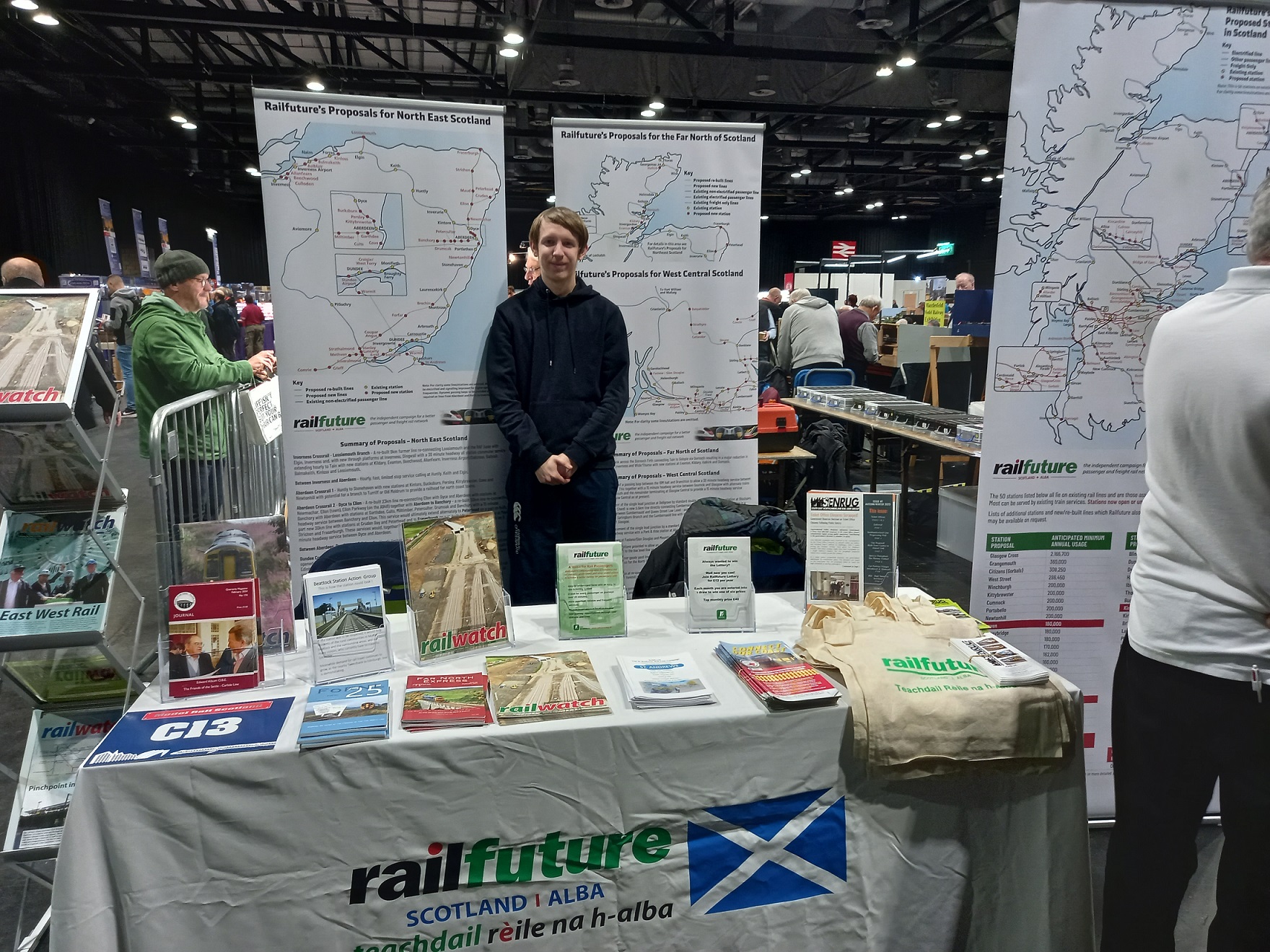
Read the latest Railfuture Scotland newsletter.
Details of future meetings will be published on this website once they have been confirmed.
A comprehensive list of events is on the main Railfuture website: events | rail dates | Railfuture national events.
MORE PASSENGERS NEEDED ON SCOTLAND'S RAILWAY
Railfuture Scotland strongly welcomes the almost 12-month suspension (initally six months but subsequently extended by three months to June 2024 and again to the end of September 2024) of peak-time fares in Scotland from Monday 2 October 2023, which the Scottish Goverment has funded and ScotRail has implemented. It is important that the public show their willingness to use rail. Railfuture hopes that it will continue even longer, perhaps permanently. There are many economic and environmental benefits in a shift towards rail, but this received a signficant setback when COVID-19 struck. We are hopeful that this trial will see an increase of travel at peak-time, where patronage was at around 73% of 2019 levels.
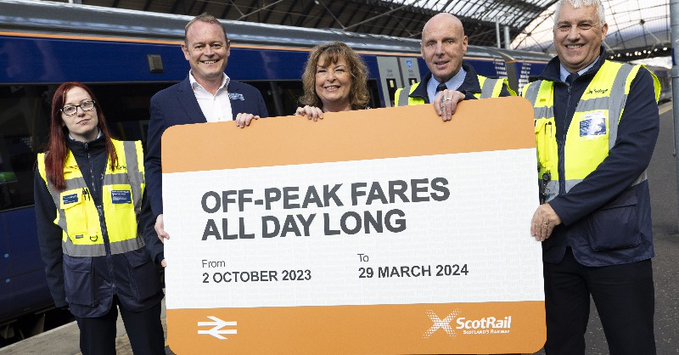
Within Britain, this fares innovation is (currently) unique to Scotland, although railways on the European mainland have gone much further, such as Germany's initial €9 a month ticket for public transport, which was relaunched at €49 a month — still very good value — and Austria's annual KilmaTicket for unlimited travel.
When the COVID-19 pandemic began, and until 2022 when it ceased to be headline news, Government advice was frequently not to travel by rail unless "essential", "necessary" or "absolutely necessary" — the words seemed to vary across train operators and government departments. These negative messages were continued longer than necessary, especially compared to other European countries, in Railfuture's view. Alarmingly, the rail industy continues to issue such 'blanket' messages when there are operational problem such as engineering works, bad weather and strikes — apparently to avoid dealing with stranded passengers face-to-face at stations — rather than informing the public clearly what is and is not running so that they can make their own decisions and appropriate plans.
Such actions had created the greatest risk to the future of the railway for decades, and potentially collapsing the sustained growth seen since 1995. Fortunately a desire to travel along with public confidence in the railway has led to a major recovery in passenger numbers (particularly a switch towards more leisure travel) although revenue from passengers is still lagging behind 2019.
Railfuture believes that train services should be promoted and that reliable information is vital. It has campaigned for a full service to be reintroduced, and for incentives to travel especially special fares. Railfuture is pleased that the Scottish government has responded to our call, but we still look forward to other interventions.
In 2020 Railfuture Scotland secretary, Jane Ann Liston, wrote about Attracting people back to rail.
Much of the content on this website is about improvements to the rail network in Scotland — Railfuture calls for investment to be continued. There have been several new stations, such as Reston (May 2022), East Linton (December 2023) and Inverness Airport (February 2023). Particularly exciting is the reopening of the railway line to Levenmouth, which is Progressing well with the public service due to commence in June 2024. Scroll down to read more.
RAILFUTURE CAMPAIGN SUCCESS
NEW STATIONS IN SCOTLAND
Railfuture supports new stations where there is sufficent demand and trains can call without signficant impact on the journey time or affecting the timetable so that non-stopping trains after adversely affectred. Several new stations have opened in recent years.
The latest was East Linton, in December 2023. A YouTube video https://youtu.be/cme4ma5pmIc shows, in a humorous way, what station number 2,581 is like.
RAILFUTURE CAMPAIGN SUCCESS
FURTHER ELECTRIFICATION OF SCOTLAND'S RAILWAY
For decades Railfuture has campaigned for a rolling programme of electrification across Britain. On 28 July 2020 the Scottish Government announced a large rail electrification programme by 2035 to achieve decarbonisation. This would have seen all seven cities in Scotland (Dunfermline has since become the eighth city) served by electric trains, following electrification in recent years up to Stirling and the remaining routes between Glasgow and Edinburgh.
The map below shows the routes that were intended to be electrified by 2035. A word of caution, however. In 2008 an electrification map was produced and progress has been slower that it implied. Railfuture will be monitoring progress and challenge future Scottish governments if they rein back on the commitment for decarbonisation.
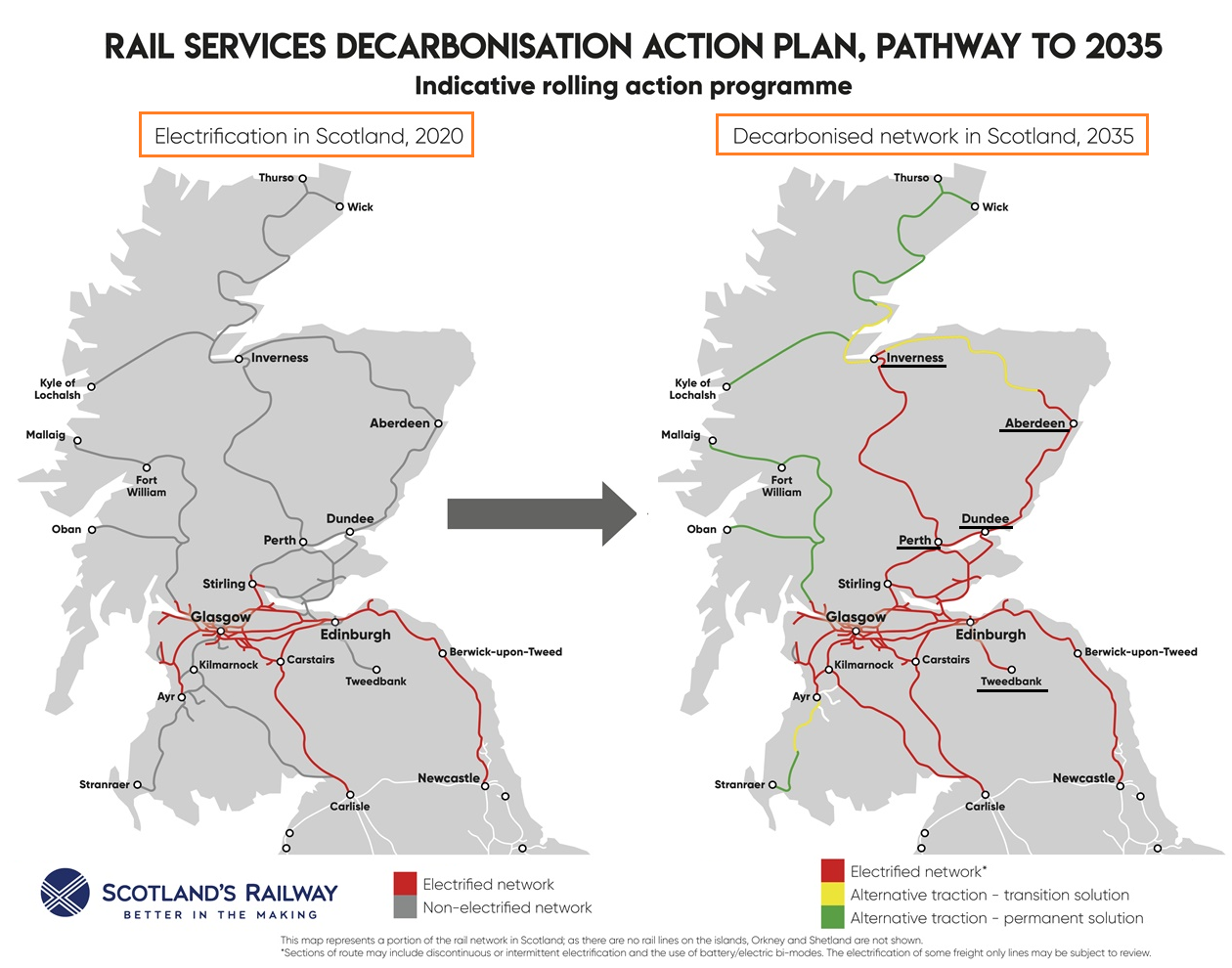
Railfuture understands that a revised programme is due to be announced soon.
RAILFUTURE CAMPAIGN SUCCESS
LEVENMOUTH RAIL LINE HAS BEEN RE-INSTATED
Thursday 8 August 2019: Railfuture Scotland was delighted when the Scottish Transport Secretary, during his visit to Levenmouth, announced the green light and £75m for reopening the rail line to Levenmouth for passenger services. It was great news for this long running saga, which will benefit a deprived area of Fife.
Strictly speaking, at the time of that announcement, only the detailed design phase was committed, not implementation. However, Transport Scotland only performs the detailed design when the green light has been given by the Minister. Of course, the railway has since been completely rebuilt and will open to the public in June 2024, just before Railfuture holds its national AGM in Edinburgh.
In early January 2024, approval was given to operate trains on the line, meaning that driver training could commence (see news story). Since then, an opening date of 2 June 2024 has been announced (see video on X/Twitter). The reopening was covered in a 2019 Railfuture article Levenmouth on track.
Congratulations to the hard-fought Railfuture-affiliated Levenmouth Rail Campaign, which made a strong case for the reopening of the mothballed line at Railfuture's conference in 2016 to celebrate the reopening of the Borders Railway.
Initial news reported in https://www.fifetoday.co.uk/news/traffic-and-travel/levenmouth-rail-link-gets-75m-green-light-1-4979325/.
EVERY PASSENGER MATTERS
Railfuture Scotland plays its part in promoting Railfuture's campaign for better services over a bigger network, with a railway that is focussed on providing the best possible service and passenger experience. For an industry that often seems to do what is operationally easiest rather than what is best for its customers, Railfuture reminds all of Britain's train operators and Network Rail that every passenger matters.
Although this website covers in detail some of the recent line and station reopenings in Scotland, along with infrastructure upgrades, such as electrification, it is vital that passengers have fast, frequent, convenient, comfortable, reliable, safe, and value-for-money train services in which the journey experience is enjoyable and productive. Railfuture campaigns for all of these aspects, even small things such as sufficient ticket machines, toilets, and trains with Wi-Fi and power points. The little things matter.
Railfuture across Britain, not just in Scotland, needs more members, especially women and young people, so if having a bigger and better railway that is value for money is what you want, please become a member - for just £20 (or £14 if under 26). Apply to join online now.
RAILFUTURE SCOTLAND'S RAIL EXPANSION PLANS
Back in 2014 Railfuture Scotland published its proposals to expand Scotland's rail network - read our press release. These plans are stil relatively unchanged.
The Scottish media publicised Railfuture Scotland's proposals - see below.
- Scotsman article: https://www.scotsman.com/news/transport/expansions-for-scotlands-rail-network-proposed-1520711
- CILT article: http://ciltuk.org.uk/News/LatestNews/tabid/235/ctl/NewsItem/mid/589/Id/4635/Default.aspx
These proposals include a top 50 list (view or download) of stations to be opened or re-opened from Beattock to Culloden, with a further 45 to follow. This is quite realistic considering that about 70 stations have been added to the Scottish network over the past 30 years. New passenger and freight lines are also proposed.
However, it's not all about new infrastructure. Railfuture Scotland is calling for faster and more frequent trains on existing routes, including more electrification, which should be speeded up.
BORDERS RAILWAY — BRITAIN'S LONGEST REOPENED LINE
Patronage far exceeded expectations
Passenger services on the re-built Borders Railway from Edinburgh to Tweedbank commenced on Sunday 6 September 2015, more than 46 years after the last trains ran on 6 January 1969, as described in details (with photos) HERE (also see the BBC report). The line, which is the longest domestic rail line in Britain constructed in more than a century, cost £353 million comprising £295 million (2012 prices) for construction plus almost £60 million for legal and land costs. A speeded-up video of the journey from the rear cab of the train can be watched on BBC website.
Railfuture Scotland has produced a leaflet about the Borders Railway reopening (published as a pull-out in Railwatch magazine issue 145) and also held a public event in the new Transport Interchange at Galashiels a few weeks after the reopening. In the first month since reopening there were 125,000 passengers, which is double the predicted monthly average, with some trains being overcrowded. At Galashiels station more people boarded a single train than predicted for the entire day. Published figures (6 September 2018) showed more than 4 million passenger single journeys in the first three years of the line's reopening, with 1.5 milion in the third year alone. This compares to 1.3 million in the first year, which was almost 100,000 above the year 1 forecast in the business case that was produced in 2012. Initial teething troubles, such as late-running trains and an unacceptable number of cancelled trains because of train faults and limitations of the largely single-track route, affected patronage. Even so the reopened railway is a success story, and joins the success of the other lines in Scitland such as Larkhall to Milngavie, Airdrie to Bathgate and Stirling to Alloa. It has also helped to make the case for other reopenings such as Levenmouth, which is being rebuilt and was one of Railfuture Scotland's key reopening campaigns.
The economics of a rail service is determined not simply by the patronage but by the proportion of the time that seats are occupied. In fact the Borders Railway service has been much more economically viable than comparison against the business case would suggest. This is because, in just the first year of operation, the number of passengers at the Tweedbank terminus was 681% higher than predicted and the penultimate stop at Galashiels was 330% above prediction - a total of 550,000 passengers in the year versus the 90,000 estimated. Passenger numbers for stations closer to Edinburgh (where the journeys would have been much shorter) mainly fell short of predictions. If, as appears to be the case, the majority of the unpredicted journeys were along the full length of the line to/from Edinburgh Waverley station then the number of passenger kilometres — and therefore the revenue collected — is substantially higher than the estimates in the business case.
Michael Matheson, Cabinet Secretary for Transport, Infrastructure and Connectivity since 2018, has described the Borders Railway as "a phenomenal success...bringing benefits to the local economy" with the line "acting as a catalyst for investment while opening up employment, leisure and education opportunities for communities along its length." Further evidence of the value of the new railway came from the Scottish Tourism Economic Assessment Monitor. It said that from January to June 2016 visitor days in the Scottish Borders were up by almost 11% compared to the same period in 2015, which was just before the railway reopened.
The media has reported that Scottish Borders Council and Scotrail are considering improvements to the 'inadequate' facilities at Tweedbank station, which is the terminus, to cope with a much higher than expected number of passengers.
A book entitled "WAVERLEY ROUTE: The life, death and rebirth of the Borders Railway" by David Spaven provides a great insight into the line. He was one of the speakers at Railfuture's national conference in Newtongrange on 18th June 2016.
SCOTLAND'S TRAIN OPERATORS
There are two train operators in Scotland that are controlled by the Scottish government.
The main operator is ScotRail, which has been a publicly-owned company since 1 April 2022. Prior to that, it was a franchise operated by Abellio, which had taken it over from First Group on 1 April 2015.
The smaller opertor is the Caledonian Sleeper, which has seen a €200m investment for 75 new coaches comprising four trains of 16 coaches (plus 11 spare coaches) operating the Highland and Lowland services. It was nationalised on 25 June 2023. It has only existed as standalone operator since 31 March 2013, when it was created out of ScotRail.
Railfuture is a non-political organisation and does not care whether train operators are in the public or private sectors. It is not ownership that matters but the performance of the operator: whether it puts passengers first, and that is mainly down to the quality of the management, attitudes of the staff, and the relationship with the government, particularly whether the operator has freedom to what is right for its customers.
Railfuture Scotland has not generally commented on the ownership changes in 2022 and 2023 because the railway has been in turmoil since the COVID-19 pandemic and needed time to stabilise and regain passengers. However, back in 2014, when there was more certainty, it issued a press release on the day after Abellio was announced as the winner of the new ScotRail franchise following a bidding competition that had lasted many months.
At the time, Allison Cosgrove, Chair of Railfuture Scotland said: "Railfuture Scotland has enjoyed a good relationship with First during the current franchise, and First management have always been approachable and helpful. We appreciated the re-instatement of the Edinburgh-Dunbar local service which they instigated in 2010. However, having talked with all the bidders, Abellio were the most receptive to our ideas on new stations, and were the only bidder to ask us back for an in-depth study of our 50 Stations proposals. We await with interest to see what is included in the optional additions to the franchise, and hope that they have adopted some of our suggestions." Much the same could be said of the current situation.
Alex Hynes has remained the Managing Director of the ScotRail Alliance, which puts him in charge of both the train operator and the infrastructure operator, Network Rail, in Scotland. He spoke at the Railfuture AGM in May 2018. He said that his intention, not just ambition, is to give Scotland the best railway it has ever had. At the time, ScotRail had started to introduce brand new eletric Class 385 trains manufactured by Hitachi. These 46 three-car and 24 four-car trains now operate along newly electrified lines on Edinburgh-Glasgow and Stirling-Alloa. He also mentioned the full refurbishment of the existing train fleet aloong with the refurbised 'high speed trains' (HSTs) between Scotland's seven cities.
Railfuture Scotland chair Allison Cosgrove wrote in October 2018: "I'm delighted to see wonderful coverage of Scottish railways in the current edition of both RAIL and Modern Railways magazines. I emailed Alex Hynes to congratulate him and he replied: added 'Now we just have to deliver it!'"
NEW EDINBURGH TRAM LINE PROPOSED
On 1 Februry 2024, a cross-party coalition of Edinburgh councillors voted to support a proposal to build a second line for Edinburgh's tram system. Because of the planning and other procedural rules, it would cost about £44 million just to develop an Outline Business Case and Final Business Case (and other associated pre-construction work). The new north to south-east line would run from Granton (on the Firth of Forth) via the city centre to the BioQuarter and Edinburgh Royal Infirmary. There will be a 12-week public consultation (which includes several route options) in spring 2024 ahead of preparing a Strategic Business Case.
EDINBURGH TRAM EXTENSION TO NEWHAVEN OPENED ON 7 JUNE 2023
The first public trams on the Newhaven extension left at 12:00 on Wednesday 7 June 2023. Departures from Picardy Place in Edinburgh and also at Newhaven left at the same time. The first tram arrived at Newhaven at 12:19 and was packed.
Railfuture's Instagram has some photos: [Newhaven 1] [Newhaven 2].
According to a news article, the city's council leader said the number of passengers using the tram system had doubled in only a fortnight after the extension opened.
Contruction work on the Edinburgh Trams extension from York Place (close to Waverley station) to Newhaven (via Leith) was complete in early 2023 with testing ramping as the opening got closer. On Monday 5 June, two days before opening, an 'enhanced servce' involving 23 trams operating on the entire system betwwen Edinrbirtgh Airpot and Newhaven. An unconfirmed (worst case) opening date of 21 June 2023 had been announced, but the opening was achieved a fortnight earlier. Patronage across the whole system is predicted to total 16 million journey a year. For more information about the project, click [http://www.edinburgh.gov.uk/tramstonewhaven/].
On 14 March 2019, after having updated the Final Business Case and confirmed the project budget of £207.3m, City of Edinburgh councillors gave approval (voting 36 to 26 in favour) to extend the Edinburgh tram network by 4.5km to Newhaven, Ocean Terminal or the foot of Leith Walk. The construction contract was signed in-mid 2019, with work beginning on Monday 18 November 2019 in two sections of Constitution Street. This followed six months of joint work by the Council and contractors to finalise the construction programme.
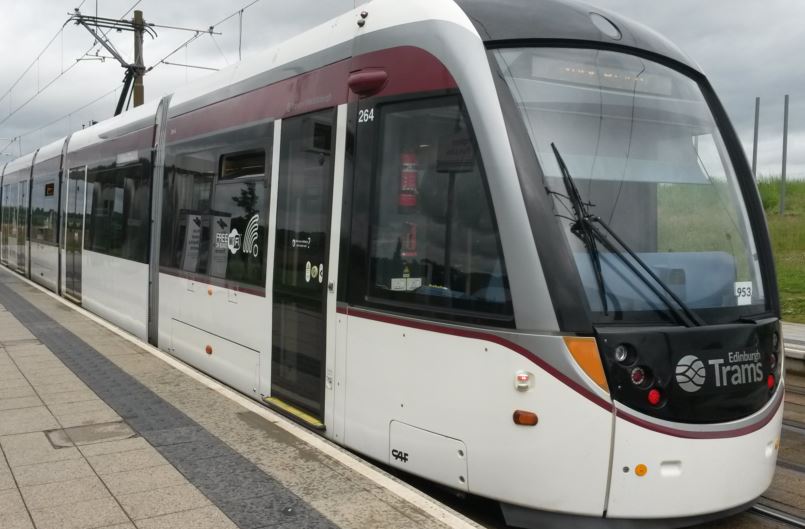
In the first year of tram operation, which commenced on 31 May 2014 (see BBC report), passenger number were 10% higher than forecast with three million people using them. During the first year of operation, as is expected with most businesses, the trams made a loss, which was less than 10 pence per journey. However, the above-expected patronage ensured that the and the trams soon started making a profit, generating a pre-tax operating profit of £252,000 in 2016 against a forecast pre-tax loss.
The better-than-forecast patronage has continued: 4.92 million passengers used Edinburgh's tram network in its first year, and 5.38 in the second year, which is 6.7% greater than the target set before the opening. In July 2016 a new timetable was introduced with trams running every five minutes in the morning and evening peaks. Passenger journeys totalled 6.6 million in 2017 having increased by more than one million (19%), thanks to a new timetable launched at the beginning of 2017 to increase capacity, further improve frequency and reduce journey times.
On 7 January 2019 figures were released showing more than 7.3 million journeys were recorded in 2018, which is an increase of 10 per cent on 2017. This was partily achieved by introducing "queue buster" services during morning and evening peaks, which sees trams running from every three minutes. The tram system continues to go from strenth to strength.
In early October 2018 at the Global Light Rail Awards recognised Edinburgh Trams in all four of the categories it was shortlisted in. It won Operator of the Year (which it previously won in 2015 and 2017) and was highly commended for Environmental & Sustainability, Most Improved System and Technical Innovation infrastructure.
Click [HERE] for more info by Railfuture Scotland.
ALMOND CHORD CAMPAIGN
Railfuture Scotland has long called for the Almond Chord to be built sooner than later. This west-to-south chord near Dalmeny, along with the use of part of an existing freight spur, would provide an alternative connection between the Edinburgh–Glasgow and Edinburgh–Aberdeen main lines, which would be useful when there was disruption on the rail network. In particular, it would bypass the flooding-prone Winchburgh tunnel, and could also enable some trains to and from Glasgow to serve Edinburgh Airport.
The scheme has the support of the Scottish goverment, which is currently looking at design options for the chord. This will determine whether there will be a flyover at a) just Almond Junction, b) at both Almond and Winchburgh junctions or c) neither. Flyovers will increase capacity as a train would not have to wait to cross the path of another, but obviously it would be a more expensive scheme. Railfuture's preference on such schemes is for maximum capacity to allow as many trains to operate as possible.
Had the chord been constructed several years ago, as Railfuture Scotland has proposed (click here to see our flier about it), then passengers would not have had their journeys disrupted for several weeks by the closure of the railway line between Linlithgow and Edinburgh Park to fit paved track (and renew drainage) in Winchburgh tunnel to create more clearance to carry overhead wires for the electrification of the line (part of the EGIP [Edinburgh-Glasgow Improvements] project).
Railfuture
Railfuture is Britain's leading independent organisation campaigning for better rail services for passengers and freight. Railfuture is a voluntary group representing rail users, with 20,000 affiliated and individual members. It is not affiliated to or funded by train companies, political parties or trade unions. Every member gets one vote at its AGM.
Railfuture campaigns for cheap and convenient rail services for everyone; better links for buses, bikes and pedestrians; policies to get more heavy lorries on to rail; new lines, stations and freight terminals - a better rail service and a bigger rail system for both passengers and freight. Our volunteer members in branches and around 300 local rail user groups across Britain campaign to get stations and lines reopened, and services and facilities improved, for the benefit of the community, economy and environment.
Over the past 50 years we have played a major part in getting over 370 new and reopened stations and over 500 miles of route to join the network. Apply to join our campaign today - click Join Now using your credit/debit card via PayPal.
Railfuture Scotland Campaigns, News, Events and Contacts
Campaigns - Click [here] for a list of the main Railfuture Scotland campaigns.
Campaign resources - Click [here] for a list Railfuture Scotland campaign resources.
Newsletter - Click [here] to read back issues of 'Branch Notes' the Railfuture Scotland newsletter.
Events - Click [here] for details of conferences and other events organised by Railfuture Scotland.
Contacts - Click [here] for Railfuture Scotland contacts.
Gallery - Click [here] for the Railfuture Scotland photo gallery.
Links - Click [here] for links to external Scottish websites (including other campaign groups).
Twitter - ![]() Click @RailfutureScot for the Railfuture Scotland twitter account.
Click @RailfutureScot for the Railfuture Scotland twitter account.
Meeting Railfuture and working with us
Railfuture Scotland would be pleased to give a presentation about its work and railways in Scotland to interested groups. On 4 April 2019 we gave a presentation (see slides) on the 'passenger experience' to Edinburgh-based Capital Rail Action Group, which like Railfuture campaigns for a better public transport, especially rail and light rail.
Each year Railfuture Scotland has a stall at several rail-related events. The photo below, taken on 13th October 2018, shows three Railfuture volunteers, including chair Allison Cosgrove and secretary Jane-Ann Liston, meeting rail users and discussing our campaigns. it is also a chance to find out about how you can join us and take part in our campaigning.
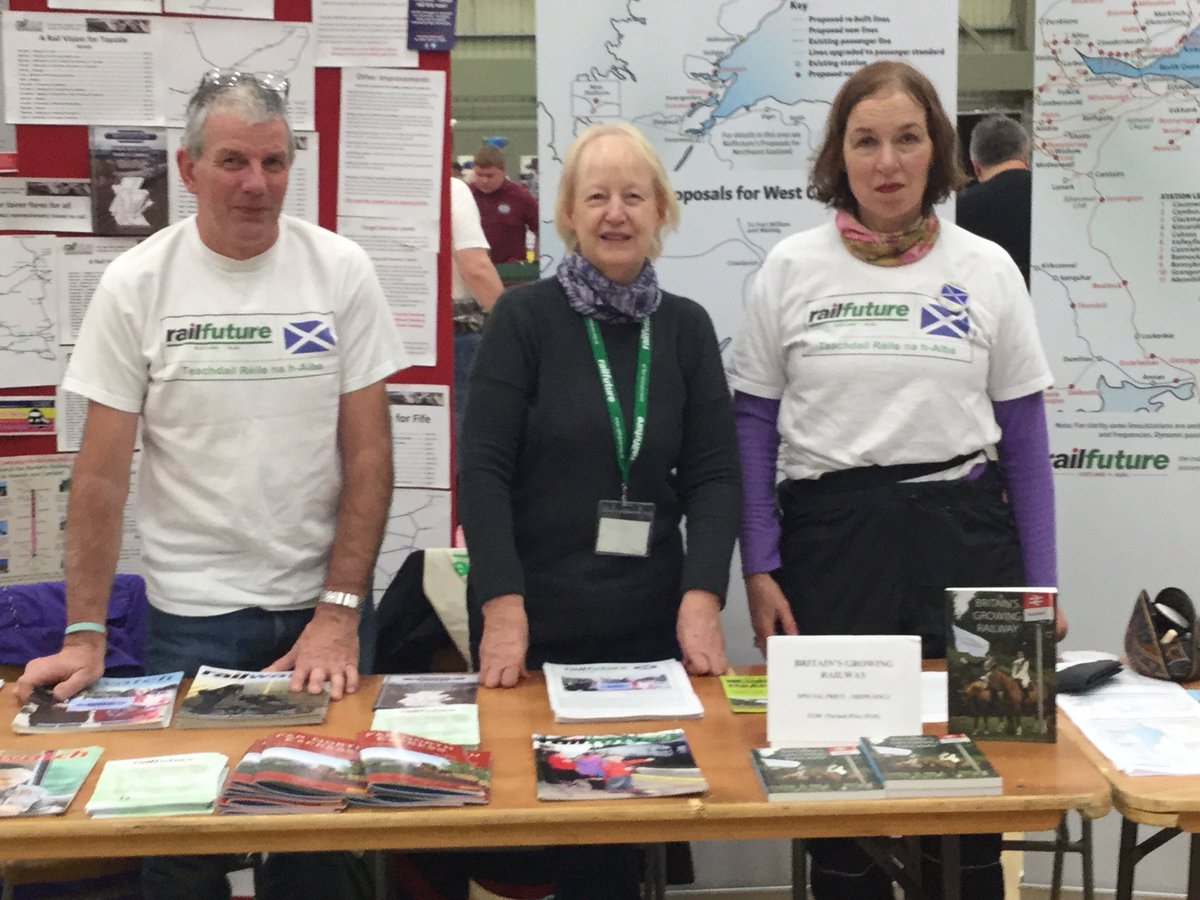
Railfuture engages with politicians from all political parties at Westminster and the devolved governments in Scotland and Wales. At the national AGM Railfuture members appoint Honorary Vice Presidents. These include rail professionals, specialist journalists and politicians amongst others. Railfuture has Vice Presidents from all major political parties. In Scotland one such person is Paul McLennan MSP, who invited Railfuture Scotland delegates to Holyrood in January 2023. A previous VP was Stewart Stevenson MSP and the Railfuture Scotland committee took him out for a meal (see photo below) and he then attended the committee meeting afterwards.

The photo above (click it for a higher resolution image) shows (left to right) Allison Cosgrove, chair, Stewart Stevenson, Ron McLean, Lawrence Marshall, Jane Ann Liston, secretary, Anthony Lennon, Barrie Forrest, Roddy McDougall and Ken Sutherland. Stewart has extensive knowledge of the rail network and as well as being very informative and helpful to Railfuture.
As well as organising the annual national conference for rail users and user groups, Railfuture works at local and national level with train operators and other stakeholders to secure a better railway. Railfuture makes awards to campaigners from its Fighting Fund to bring about improvements. Awards have been given, for example, for publicity initiatives and feasibility studies.
Join Us - Become a Member
If you would like to join our campaign for a rail future please go to the Join Us page to apply for membership. It is just £18 (concessions available) which provides four all-colour magazines a year plus more. If you have any questions or comments about the work of Railfuture Scotland you can contact piur secretary (see contacts page).
The independent campaign for a better passenger and freight rail network
Tweets by RailfutureScot
Privacy: For information about the use of cookies on this website, please see cookie settings.
This website is hosted by TSO Host (cPanel) and maintained on Railfuture Scotland's behalf by Billing Specialists (Edinburgh) Ltd.

